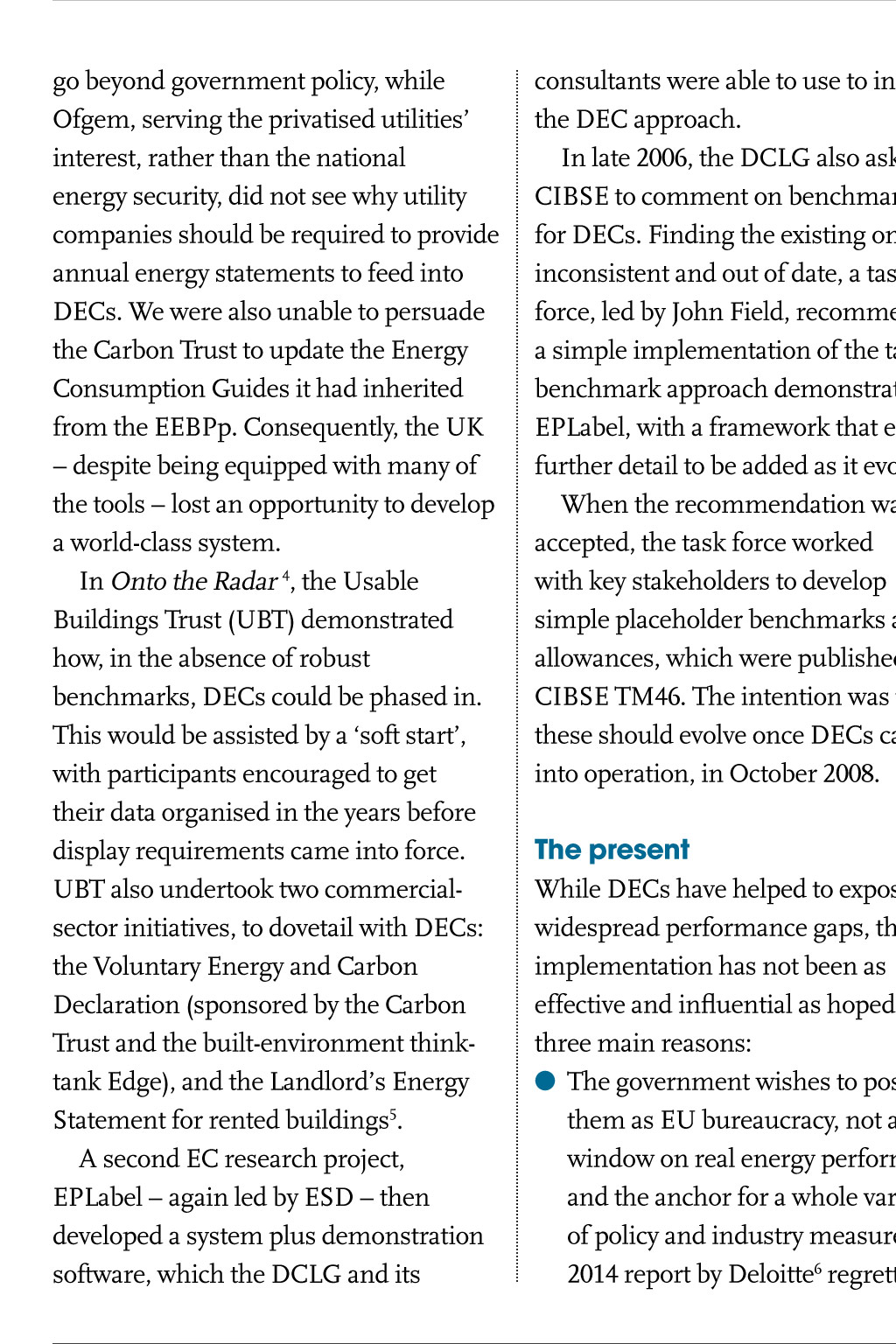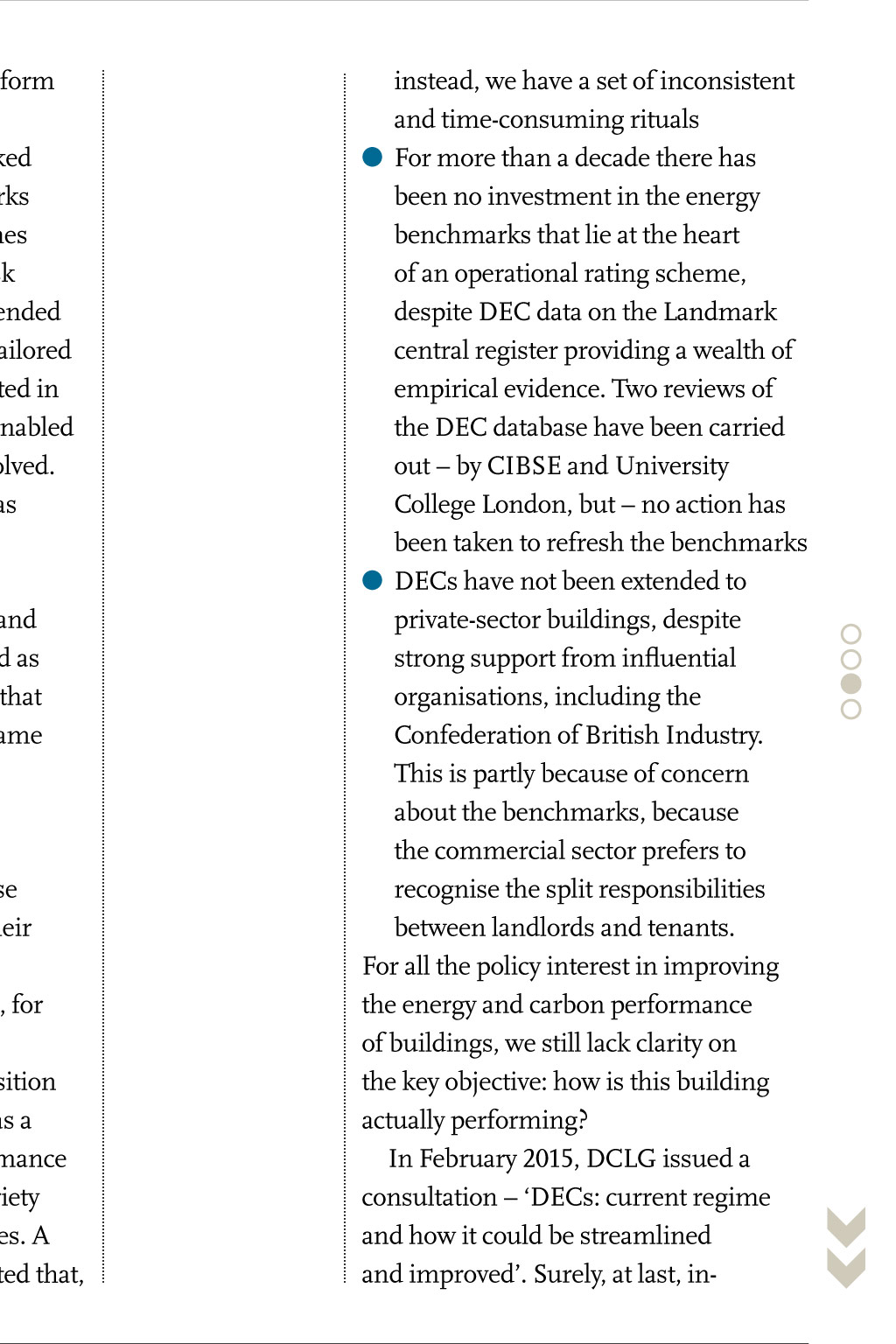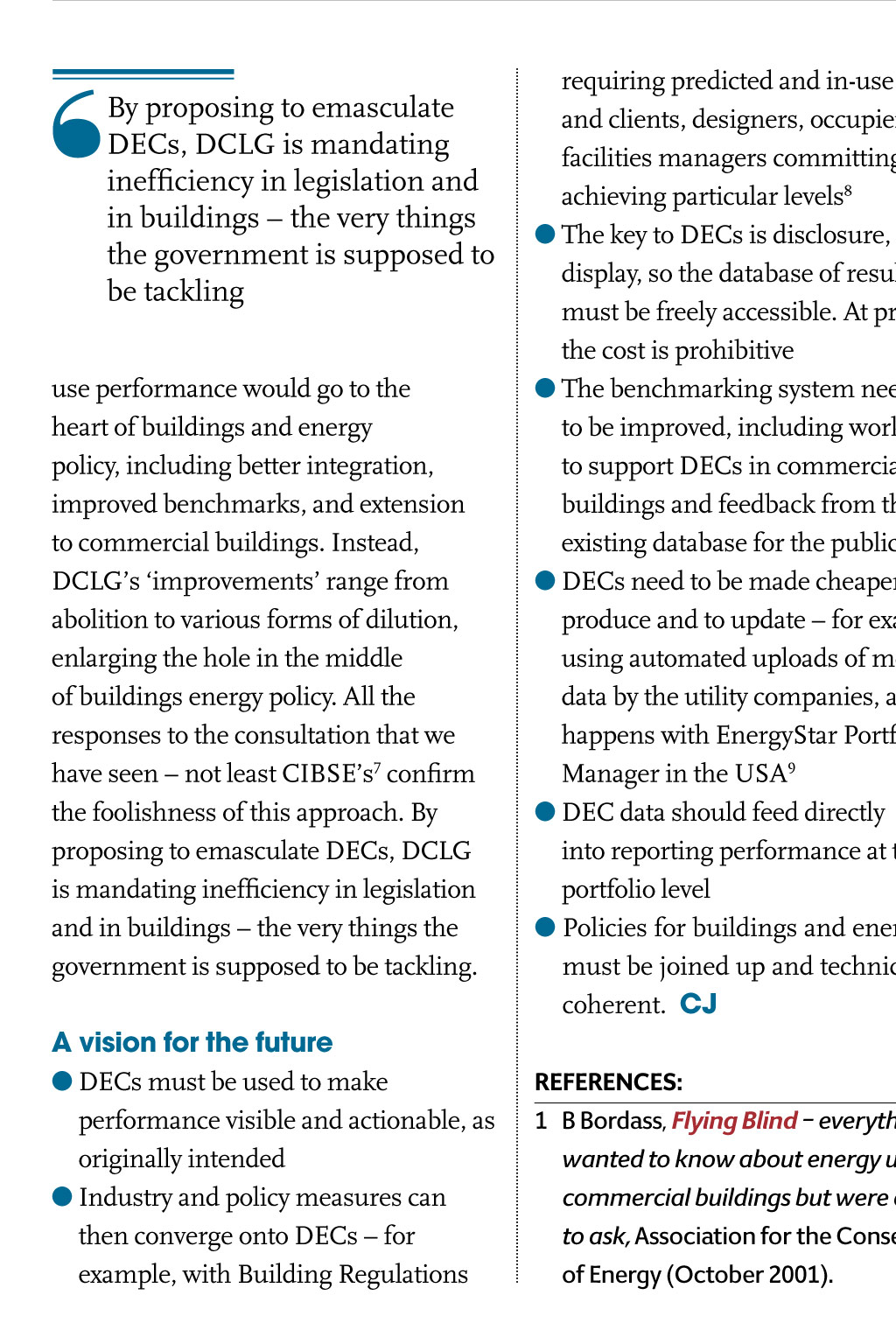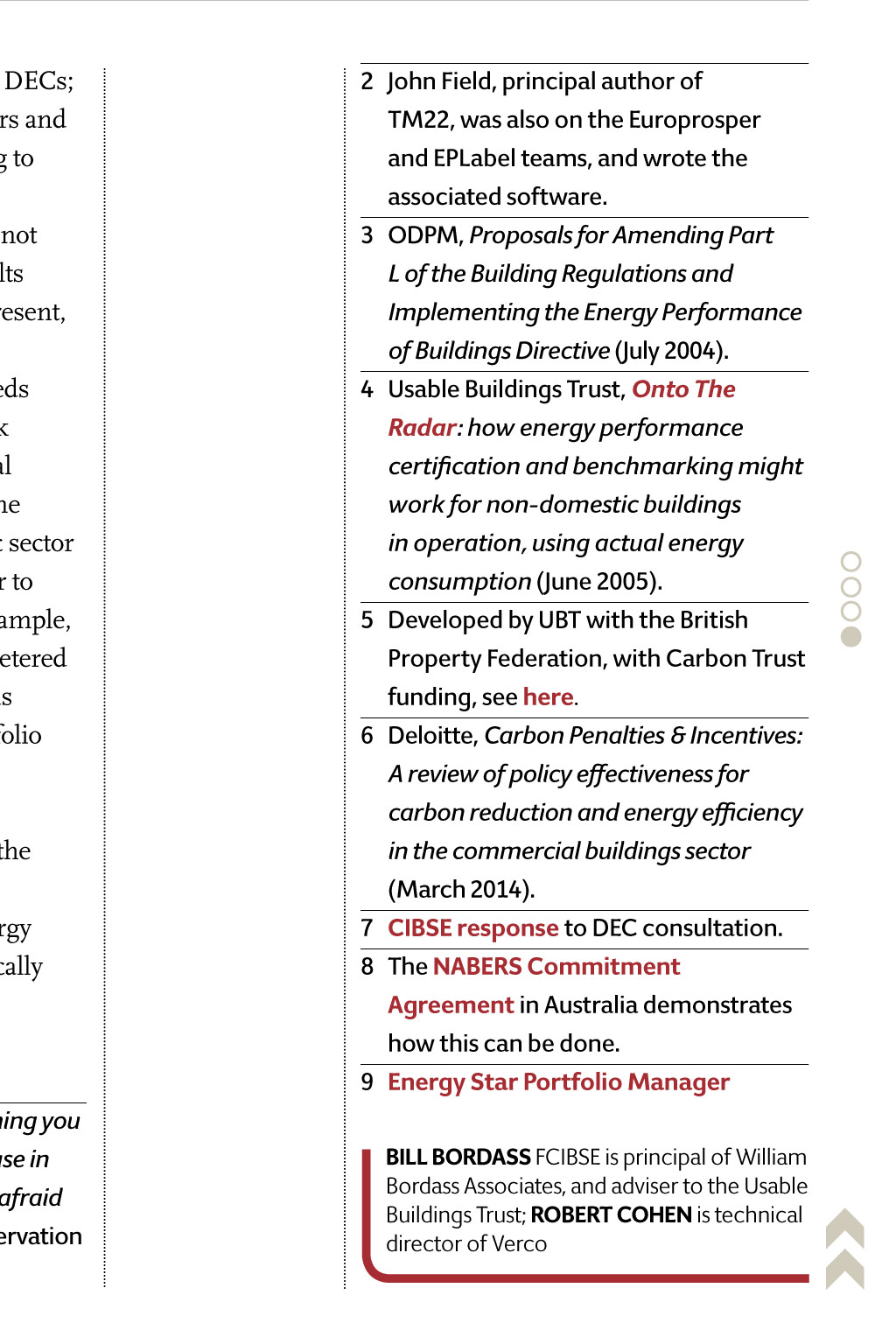
















Policy Decs Making Decs Fly The government is proposing to loosen the requirement for Display Energy Certificates. Arguing that they are essential for closing the performance gap, Bill Bordass and Robert Cohen put forward a plan for widespread adoption C ase study evidence of performance gaps has been around for many years. In Flying Blind, published by the Association for the Conservation of Energy in 20011, Bill Bordass discussed reasons for the difference between predicted and actual performance of buildings. In his preface, the author regretted how responsibility for nondomestic buildings and energy was being dispersed from the former Department of the Environment to three departments and the Carbon Trust. Policy rhetoric at the time professed joined-up government but this seemed more like a jumbling up. The creation of the Department of Energy & Climate Change (DECC), in 2008, jabbed another set of fingers into the pie, not to mention the Treasurys interventions. Flying Blind recommended making in-use energy performance visible and actionable, so that good performance would become a duty for building professionals, and a badge of good management for occupants. This needed a clear, common language to communicate energy performance at all stages of a buildings life-cycle, and to help motivate those involved to do their bit. Just as Flying Blind was being completed, the European Commission published a draft of what was to become the Energy Performance of Buildings Directive (EPBD), including energy certificates. In response, a postscript to the text highlighted key points from the draft and expressed the hope that the EPBD would be the spur to making energy performance visible. The EPBD was ratified in December 2002. To support its transposition in six countries both of us were working on Europrosper, an EU research project set up by ESD (now Verco) to explore methods of labelling office buildings for their in-use energy performance. This made substantial use of British developments, in particular, the CIBSE TM22 Energy assessment and reporting methodology 2, the Energy Consumption Guide 19 for offices, from the governments Energy Efficiency Best Practice programme (EEBPp), and a tailored benchmarking system that Bordass had helped the EEBPp to develop in 2001, to supercede Guide 19. When Europrosper ended, in early 2004, considerable progress had been made on what were to become Display go beyond government policy, while Ofgem, serving the privatised utilities interest, rather than the national energy security, did not see why utility companies should be required to provide annual energy statements to feed into DECs. We were also unable to persuade the Carbon Trust to update the Energy Consumption Guides it had inherited from the EEBPp. Consequently, the UK despite being equipped with many of the tools lost an opportunity to develop a world-class system. In Onto the Radar 4, the Usable Buildings Trust (UBT) demonstrated how, in the absence of robust benchmarks, DECs could be phased in. This would be assisted by a soft start, with participants encouraged to get their data organised in the years before display requirements came into force. UBT also undertook two commercialsector initiatives, to dovetail with DECs: the Voluntary Energy and Carbon Declaration (sponsored by the Carbon Trust and the built-environment thinktank Edge), and the Landlords Energy Statement for rented buildings5. A second EC research project, EPLabel again led by ESD then developed a system plus demonstration software, which the DCLG and its consultants were able to use to inform the DEC approach. In late 2006, the DCLG also asked CIBSE to comment on benchmarks for DECs. Finding the existing ones inconsistent and out of date, a task force, led by John Field, recommended a simple implementation of the tailored benchmark approach demonstrated in EPLabel, with a framework that enabled further detail to be added as it evolved. When the recommendation was accepted, the task force worked with key stakeholders to develop simple placeholder benchmarks and allowances, which were published as CIBSE TM46. The intention was that these should evolve once DECs came into operation, in October 2008. By proposing to emasculate DECs, DCLG is mandating inefficiency in legislation and in buildings the very things the government is supposed to be tackling use performance would go to the heart of buildings and energy policy, including better integration, improved benchmarks, and extension to commercial buildings. Instead, DCLGs improvements range from abolition to various forms of dilution, enlarging the hole in the middle of buildings energy policy. All the responses to the consultation that we have seen not least CIBSEs7 confirm the foolishness of this approach. By proposing to emasculate DECs, DCLG is mandating inefficiency in legislation and in buildings the very things the government is supposed to be tackling. A vision for the future DECs must be used to make performance visible and actionable, as originally intended Industry and policy measures can then converge onto DECs for example, with Building Regulations The present While DECs have helped to expose widespread performance gaps, their implementation has not been as effective and influential as hoped, for three main reasons: The government wishes to position them as EU bureaucracy, not as a window on real energy performance and the anchor for a whole variety of policy and industry measures. A 2014 report by Deloitte6 regretted that, requiring predicted and in-use DECs; and clients, designers, occupiers and facilities managers committing to achieving particular levels8 The key to DECs is disclosure, not display, so the database of results must be freely accessible. At present, the cost is prohibitive The benchmarking system needs to be improved, including work to support DECs in commercial buildings and feedback from the existing database for the public sector DECs need to be made cheaper to produce and to update for example, using automated uploads of metered data by the utility companies, as happens with EnergyStar Portfolio Manager in the USA9 DEC data should feed directly into reporting performance at the portfolio level Policies for buildings and energy must be joined up and technically coherent. cJ The government wishes to position DECs as EU bureaucracy, not as a window on real-energy performance and the anchor for policy and industry measures Energy Certificates (DECs) based on actual energy use. This included: an exploration of the principles and applications; a suggested certificate design; demonstration software for offices; and training packages that had been tested and well received in the UK and the countries of the six partner organisations. In its July 2004 consultation3 on Part L and the EPBD, the Office of the Deputy Prime Minister (ODPM, later renamed the Department for Communities and Local Government DCLG) supported the idea of Operational Ratings for public display, and referenced Europrosper extensively. Unfortunately, unintended consequences of the jumbling up then began to emerge. ODPM said it could not invest in development until the minister agreed which took until June 2006. The Carbon Trust couldnt invest either, because its remit was to instead, we have a set of inconsistent and time-consuming rituals For more than a decade there has been no investment in the energy benchmarks that lie at the heart of an operational rating scheme, despite DEC data on the Landmark central register providing a wealth of empirical evidence. Two reviews of the DEC database have been carried out by CIBSE and University College London, but no action has been taken to refresh the benchmarks DECs have not been extended to private-sector buildings, despite strong support from influential organisations, including the Confederation of British Industry. This is partly because of concern about the benchmarks, because the commercial sector prefers to recognise the split responsibilities between landlords and tenants. For all the policy interest in improving the energy and carbon performance of buildings, we still lack clarity on the key objective: how is this building actually performing? In February 2015, DCLG issued a consultation DECs: current regime and how it could be streamlined and improved. Surely, at last, in- 2 John Field, principal author of TM22, was also on the Europrosper and EPLabel teams, and wrote the associated software. 3 ODPM, Proposals for Amending Part L of the Building Regulations and Implementing the Energy Performance of Buildings Directive (July 2004). 4 Usable Buildings Trust, Onto The Radar: how energy performance certification and benchmarking might work for non-domestic buildings in operation, using actual energy consumption (June 2005). 5 Developed by UBT with the British Property Federation, with Carbon Trust funding, see here. 6 Deloitte, Carbon Penalties & Incentives: A review of policy effectiveness for carbon reduction and energy efficiency in the commercial buildings sector (March 2014). 7 CIBSE response to DEC consultation. 8 The NABERS Commitment Agreement in Australia demonstrates how this can be done. REFERENCES: 9 Energy Star Portfolio Manager 1 B Bordass, Flying Blind everything you wanted to know about energy use in commercial buildings but were afraid to ask, Association for the Conservation of Energy (October 2001). BILL BORDASS FCIBSE is principal of William Bordass Associates, and adviser to the Usable Buildings Trust; ROBERT COHEN is technical director of Verco